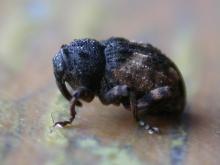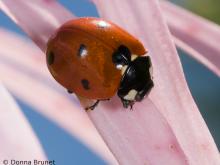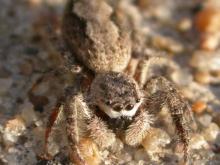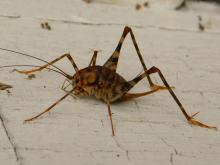Land Invertebrates
Media

Species Types
Scientific Name
About 2,500 species in North America north of Mexico
Description
Weevils are plant-eating beetles with a characteristic long, down-curving snout. The antennae are clubbed and elbowed. There are thousands of weevil species.
Media

Species Types
Scientific Name
Nearly 500 species in North America north of Mexico
Description
Lady beetles are beloved for many reasons. Farmers like the way they devour injurious aphids and scale insects. Everyone else appreciates their bright colors and shiny, compact bodies.
Media

Species Types
Scientific Name
More than 700 species in North America
Description
Ants are everywhere! They outnumber us a million to one. These colonial insects are familiar to everyone on Earth. Their lives are endlessly fascinating.
Media

Species Types
Scientific Name
About 300 species in North America north of Mexico
Description
People notice spider wasps when they notice a female lugging a captured spider to its doom. In most cases, she will drag the spider into a burrow, lay an egg on the spider, and then hunt for more spiders!
Media

Species Types
Scientific Name
More than 400 species in North America north of Mexico
Description
The name is a warning: blister beetles are famous for their chemical defenses. Beetles in this family can exude an oil that can cause a person’s skin to blister.
Media

Species Types
Scientific Name
Araneus spp.
Description
Missouri's Araneus spiders, called angulate and roundshouldered orbweavers, can be hard to identify to species. Most have camouflage patterns, and they all make characteristic, delicate, wheel-shaped webs to catch prey.
Media

Species Types
Scientific Name
More than 900 species in North America north of Mexico
Description
Millipedes, which have two pairs of legs per body segment, are harmless detritus-eaters, move slowly, and curl up defensively when harassed.
Media

Species Types
Scientific Name
About 84 species in North America.
Description
Many blow flies are so shiny and colorful they’re called greenbottles and bluebottles. But pretty as they are, it’s hard not to be repulsed by their larval diets.
Media

Species Types
Scientific Name
Platycriptus undatus
Description
The tan jumping spider usually lives on tree trunks. Its gray, tan, and brown coloration camouflages it against tree bark. There is usually an undulating pattern on the abdomen.
Media

Species Types
Scientific Name
About 150 species in North America north of Mexico
Description
Camel crickets and cave crickets are odd-looking, hump-backed insects that are commonly found in caves, basements, cellars, and similar places.
See Also



Media

Species Types
Scientific Name
Cisseps fulvicollis
Description
The yellow-collared scape moth is more often “orange-collared.” And whether you think it looks more like a firefly or a wasp, it’s still a moth!
Media

Species Types
Scientific Name
Nearly 150 species in North America north of Mexico
Description
Slim, delicate plume moths are instantly recognizable by their T-shaped silhouette, long legs, and muted shades of tan and brown. It can be hard to separate the various species.
Media

Species Types
Scientific Name
Pyrrharctia isabella
Description
Not many people know the adult Isabella tiger moth when they see one, but we’re all acquainted with its caterpillar, the woolly worm, or woolly bear.
About Land Invertebrates in Missouri
Invertebrates are animals without backbones, including earthworms, slugs, snails, and arthropods. Arthropods—invertebrates with “jointed legs” — are a group of invertebrates that includes crayfish, shrimp, millipedes, centipedes, mites, spiders, and insects. There may be as many as 10 million species of insects alive on earth today, and they probably constitute more than 90 percent all animal species.





















